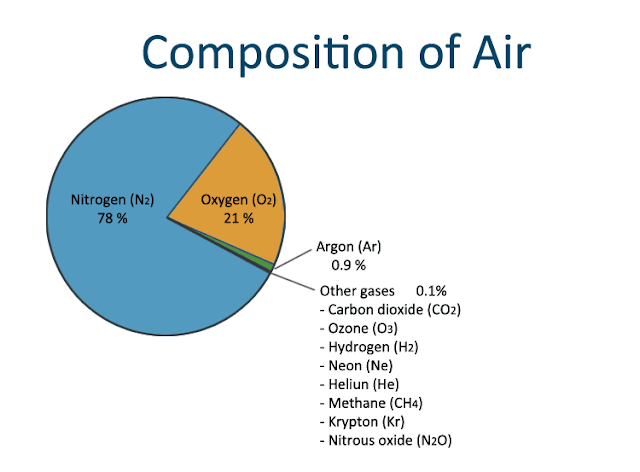What is the Composition of Air?
Human beings and other animals would not be able to survive without oxygen.
When we breathe, our lungs take the oxygen we need from the air.
Another very important gas in the air is carbon dioxide.
When we breathe out, we release carbon dioxide into the air.In daylight, plants take in the carbon dioxide they need to live and grow, and they make oxygen.
They then release the oxygen back into the air.
About four-fifths of the air is nitrogen.
We breathe in nitrogen, but we don't use it.
There are also small amounts of other gases in the air.

Green plants take in carbon dioxide from the air. Plants use carbon dioxide and water to make glucose, a type of sugar used for food energy.
Argon is one of these.
We breathe in argon but, like nitrogen, we don't use it.The air also contains tiny amounts of water vapor.

Green plants take in carbon dioxide from the air. Plants use carbon dioxide and water to make glucose, a type of sugar used for food energy.
In the process, plants give out oxygen through their leaves.
It isn't just living things that use oxygen in the air.
It isn't just living things that use oxygen in the air.
A flame needs oxygen to burn.
There's no oxygen in outer space, so you can't light a match there.Oxygen mixes with other substances too, and it sometimes changes them. Oxygen and water make iron turn to rust. As the iron rusts, it uses up oxygen in the air.
Rusting process experiment - The rusting process needs oxygen
You will need:- soap
- water
- a shallow dish
- a felt-tipped pen
- a nail or large pin
- a ball of steel wool
- a plastic cup
- a large glass jar
1. Wash the steel wool in soapy water to remove any grease.
2. Pour about 1 inch (2.5 centimeters) of water into the dish.

3. Use the nail or pin to prick the plastic cup in several places. Place the cup upside down in the water.

4. Place the steel wool on top of the cup. Put the jar over the steel wool and the cup. Mark the water level on the side of the jar.

5. Leave your experiment for a few days. Add more water if necessary. Now and then. gently rock the jar to allow more water underneath. Be careful not to let in more air.
As time goes on. the steel wool will begin to rust.
The rusting process uses up oxygen. As the air is used, the water level in the jar will rise to fill the space.
Eventually, all the oxygen will have been used up and the water will take up about one-fifth of the air space in the jar.
Can we see the air?
If you go out on a windy day, you can feel the wind tugging at your body, hair, and clothes.You can see the trees and flowers bending and the clouds racing across the sky.
Perhaps an old newspaper is blown along the road, or the smoke from a chimney is blowing out sideways instead of going straight up.
What is doing all this pushing and shoving?
What is moving everything about?
It is air.
What is doing all this pushing and shoving?
What is moving everything about?
It is air.
Air is a mixture of many different gases.
These different gases are very useful.
But they must be separated from each other before we can use them.
These different gases are very useful.
But they must be separated from each other before we can use them.
How gases are separated from the air?
Air is first changed from a gas to a liquid.It is compressed, which means it is squeezed into a smaller space, and then cooled to about - 310 °F (-190 °C).
Then the liquid air passes into a tower called a fractionating column.
The tower is warmer at the bottom and cooler at the top.
The liquid begins to evaporate, turning into gas.
Some gases evaporate at a lower temperature.
Helium and neon collect at the top of the tower.
Nitrogen evaporates next, leaving liquid oxygen at the bottom of the tower.
Separating gases in this way is called fractional distillation.


Gases from the air are used in many different ways.
People with breathing problems cannot take in enough oxygen. They are given special air with extra oxygen added to it.
Fuels cannot burn without oxygen.
A gas called acetylene burns in pure oxygen to give a very hot flame. The flame can melt metals and cut through them.
In sewage plants, oxygen is used to help change harmful substances into harmless ones.
Liquid nitrogen is very cold and is used to freeze foods quickly. It can also freeze liquids in damaged pipes so that the pipes can be repaired.
Substances do not burn in nitrogen, so it is also used inside light bulbs to keep the filament from burning away. In oil tankers, it can prevent fires and explosions.
Plants need nitrogen, so many farmers put fertilizers containing nitrogen compounds into the soil.













Social Plugin